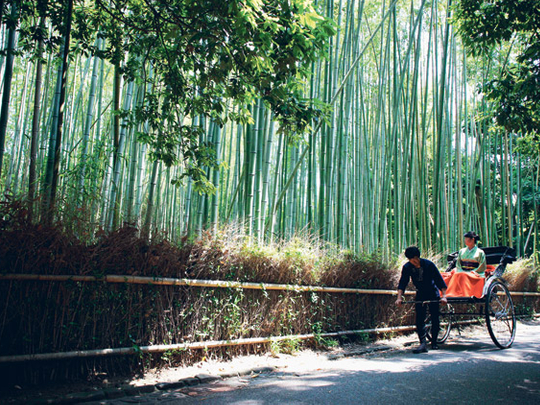
Japan changes the way you think about life. It is like being beamed into an alternative reality, where optimism and respect permeate life and modernism is fused with tradition to create exciting possibilities of how to live. I had organised my trip in and around Kyoto and Tokyo to explore Japanese food but found myself captivated by the latest fashion in ryokans (Japanese inns).
My revelation came in the form of Miyamasou, an idyllic new ryokan up in the northern mountain forests of Kyoto prefecture, famed for its wild-herb food. Once our bus passed what looked like a beware-of-bears-crossing-the-road sign, deep in the dark cypress woods, the driver put on Greensleeves to announce its arrival to the mountain hamlets.
Dropped off beside a phone booth, we were collected by a monk-like man from Miyamasou, who drove us up through the misty woods until we reached two low buildings. They lay on either side of a winding path, which continued up the mountain to a weather-beaten Shinto shrine. The air was sweet with the scent of cryptomeria (cypress) trees.
Old-school charm
We took off our shoes and were led by our smiling, kimono-clad maid to our room and served a cup of magnolia tea with a red bean sweetmeat. Like all traditional ryokan rooms, it was simple — tempered walls, tatami matted floor and a table. The only decoration was a hanging scroll and a vase with a stem of frothy white flowers in an alcove. The room was dominated by a perfect woodland view of mossy maple boughs and a gurgling brook. The glass is so clear that tiny dots are placed on it to prevent you from walking into it.
Outside, birds fluttered and the last wild cherry blossom fell in the summer rain. Everything was conducive to reflection. Home, I decided, had to be decluttered on my return, although I didn't know how I was going to replicate the delicate, fresh smell that seems to pervade Japan.
But my revelation came when I visited the loo. It is unnerving enough to find that the loo seat opens automatically when you enter the room but I was startled when it started playing Bach's Air on the G String as I touched its seat.
Despite these high-tech extras, ryokan Miyamasou still follows traditional lines, from the wooden bathtub to laying out the bedding at night on your tatami mat. Its food is exquisite, from the amazing kaiseki (multicourse dinner) consisting of wild foods such as bamboo shoot to breakfast the following morning with its miso-cured river fish (think Japanese kippers) and plum tea.
Style for the century
Other ryokans, however, are forging a "New Japanese" concept where traditional and Western elements are combined to create a comfortable 21st-century style. Hoshinoya, just outside Kyoto, and Kaichoro in Ikaho, about two hours north of Tokyo, are perhaps the most famous examples of this new style.
An hour's drive back to Kyoto took us to Hoshinoya Kyoto, where we were suddenly cast into the lap of luxury by English-speaking staff. Little temple bells were rung as we walked up from the jade green Oigawa River to Hoshinoya.
A hundred years ago, these buildings were the library of a Kyoto merchant. Inside they felt excitingly modern. There are Western elements — high ceilings, low, modern furniture designed to contemplate the river view, futons (rather than a tatami mat), English books and continental breakfast — mixed with Japanese paper screens, incense and a private wet room with a fragrant cryptomeria-wood tub. There is a public lounge area and a funky dining room, where you can eat French or Japanese food à la carte. It is more open than traditional ryokans, where guests are usually carefully screened from each other — except when they visit an onsen (hot-water spring bath).
Captivating ambience
Kaichoro in Ikaho, two hours northwest of Tokyo, in contrast, seemed more traditional, with its private dining rooms and a personal (English-speaking) maid, albeit in a modern hotel block. Crucially, though, it has delicious French-influenced kaiseki food, European furniture and each room has a private onsen overlooking the mountains.
By the time we had reached Kaichoro, our minds were so full of the Zen gardens, Noh theatre, temples and bubbling volcanic springs that we had seen, we didn't want to leave. We had arrived needing a guide but after ten days of Japanese kindness, felt confident enough to use bilingual notes and maps to communicate.












